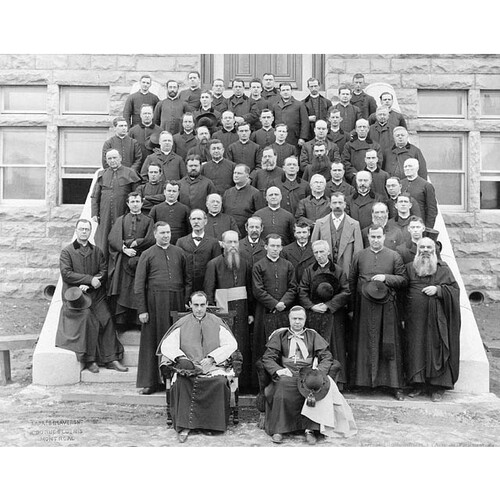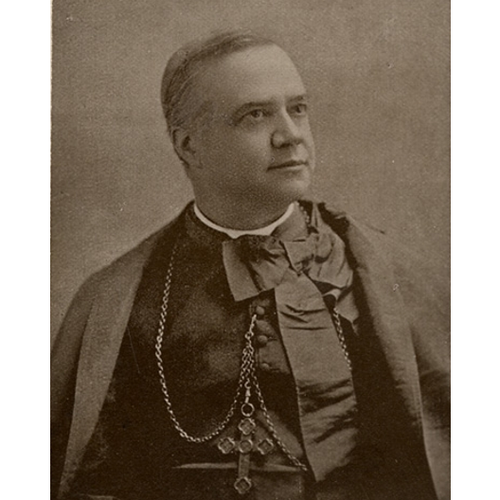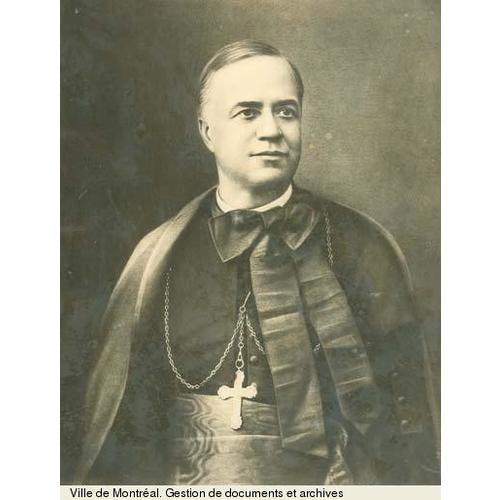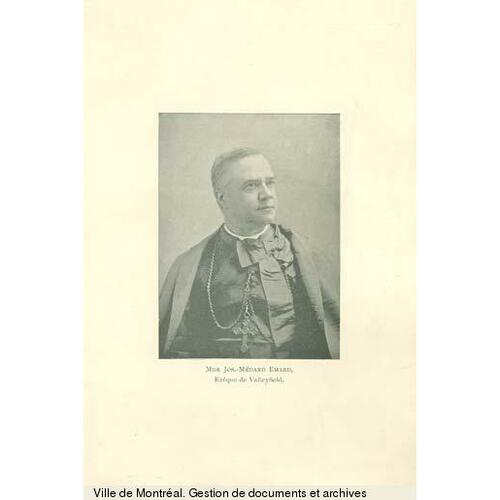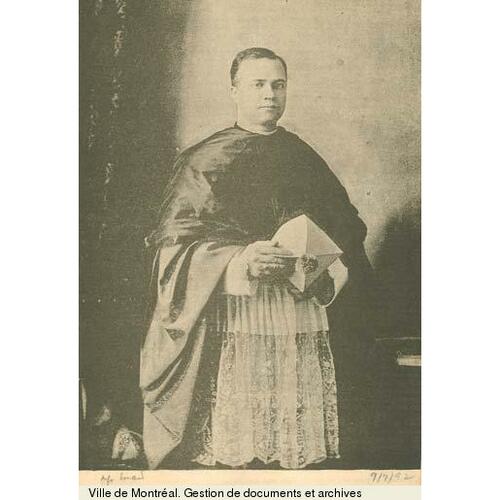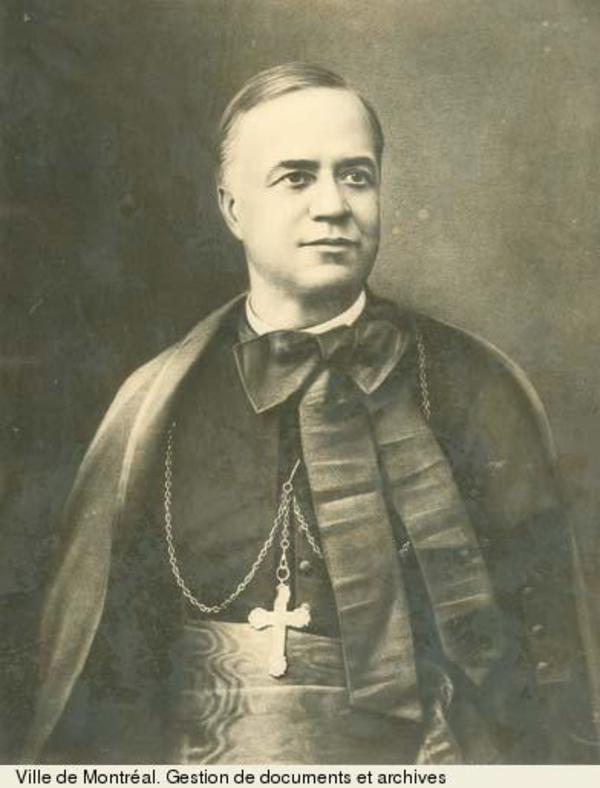
Source: Link
EMARD, JOSEPH-MÉDARD, Roman Catholic priest, professor, and archbishop; b. 31 March 1853 in Saint-Constant, Lower Canada, son of Médard Emard and Mathilde Baudin; d. 28 March 1927 in Ottawa.
Joseph-Médard Emard grew up in a family that would contribute two priests and three nuns to the Roman Catholic Church. He began his elementary schooling at the age of five under the tutelage of his father, a teacher who had recently become principal of a school in Saint-Hubert. When he was 11, he started his classical studies at the Petit Séminaire de Sainte-Thérèse (1864–67), and he completed them at the Petit Séminaire de Montréal (1867–72). In the fall of 1872 he entered the Grand Séminaire de Montréal. On finishing his theological studies, he was ordained by Bishop Édouard-Charles Fabre* of Montreal on 10 June 1876.
The young man was immediately appointed assistant priest in the parish of Saint-Enfant-Jésus. Emard was eager, however, to go to Rome, a city he associated with the grandeur, power, and triumphant influence of the Roman Catholic Church. His dream came true in the fall of 1877, when he left to study theology and canon law at the Roman Seminary. He made many friends there, both in the curia and at the French Seminary, where he lived. In his accounts of his travels he would describe with complacency the long processions of dignitaries on the occasion of eucharistic congresses and wax enthusiastic about the spiritual power of the church that these events suggested. In a letter to his father written on 9 March 1879, he showed his deep-seated love for Rome and the Roman way of doing things: “When the pope pronounces a blessing from his throne, something in his countenance is no longer of this world; one feels that there is a supernatural influence in all this.” He came back to Montreal in 1880 with two doctorates.
On his return, Emard became assistant priest of the parish of Saint-Joseph. He was appointed vice-chancellor of the diocese in 1881, and chancellor eight years later. A tireless worker who never wearied of intellectual endeavours, Emard kept himself informed on various subjects. He subscribed to a few Parisian periodicals, L’Univers, Études, and Nouvelle revue théologique, as well as to some Italian and Irish magazines. In 1883 he began contributing to La Semaine religieuse de Montréal, a journal launched the previous year that sought to make known the Roman Catholic point of view on the major issues of the day. He had many articles published in it and would become its editor in 1889. When the faculty of arts of the Université Laval in Montreal was created in 1887, he was invited to teach church history, with the rank of professor. In 1922 he would become a member of the Royal Society of Canada.
On 5 April 1892 Leo XIII appointed Emard titular bishop of the new diocese of Valleyfield. Consecrated on 9 June, he would remain in charge of Valleyfield for 30 years. The new bishop was only 39 and had virtually no experience in parish work. On the other hand, he had a solid theological and canonical education. In addition, the 11 years he had spent in diocesan administration had prepared him well for the episcopate by making him familiar with all aspects of the life of the Canadian church and putting him in touch with its leading figures: Paul Bruchési*, the archbishop of Montreal from 1897; Narcisse-Zéphirin Lorrain, the first bishop of Pembroke, Ont., from 1898; Joseph-Alfred Archambeault*, the head of the newly created diocese of Joliette, Que., from 1904; and Zotique Racicot*, the first auxiliary bishop of Montreal from 1905.
The diocese assigned to Emard was relatively small. Surrounded by the archdioceses of Montreal and Ottawa, and by the dioceses of Alexandria, Ont., and Ogdensburg, N.Y., it had some 50,000 Catholics and 35 parishes, organized into five districts: Vaudreuil, Soulanges (Les Cèdres), Châteauguay, Beauharnois, and Huntingdon. A number of religious communities were already at work there: the Sisters of the Holy Names of Jesus and Mary, the Sisters of Charity of Providence, the Sisters of St Ann, the Sisters of Charity of the Hôpital Général de Montréal, the Congregation of Notre-Dame, and the Clerics of St Viator. Emard would complete the embryonic diocesan structure bit by bit. In 1893 he got the property of the parish of Sainte-Cécile transferred to the episcopal corporation. Then, over the years, he enlarged the bishop’s palace, built the cemetery chapel, renovated the cathedral (which would be decorated by Toussaint-Xénophon Renaud), and bought a summer house in Port Lewis, near Saint-Anicet, for the seminarians. On the educational side, he soon built a kindergarten and the Collège de Valleyfield, to be followed by a normal school erected in 1908. He had brought the Little Sisters of the Holy Family to the palace and the seminary in 1900. Two years later he welcomed the first Poor Clares, who had come to set up a monastery in Salaberry-de-Valleyfield [see Marie-Louise-Thérèse Lemoine]. In 1904 he put the Sisters of Charity of Providence in charge of the newly opened hospital, housing it in the former Petit Séminaire. He founded six parishes, divided his diocese into three deaneries (vicariates forane), and in 1920 officially installed his canonical chapter. This bustling activity required a sustained effort from everyone. For a long time the diocese carried heavy debts: $80,000 for the bishop’s palace, $25,000 for the kindergarten, and $88,000 for the college. But Emard did not win every dispute, and this situation must have been humiliating for a man so conscious of his own authority. The canonical erection in 1913 of the parish of Immaculée-Conception, in the Bellerive district, which was practically forced on him by the militant attitude of the curé and the parishioners, brought this significant admission: “For, remember, I have never wanted a church in Bellerive, and I [still] don’t want one!”
According to his contemporaries, Emard showed good judgement, kindness, wisdom, and prudence. A man of medium height, with a majestic and measured gait, he cut an impressive figure. Meticulous in both dress and deportment, serious and calm in his deliberations, prudent and firm in his decisions, he was fond of solemn liturgical entries into his cathedral with the tolling of bells. He celebrated church services with great dignity and always preached from the balustrade, bearing his crozier, and adorned with mitre and pontifical decorations. In conversation he was affable and courteous. This carefully cultivated formality created a distance between him and those with whom he spoke, which could be interpreted as coolness or even duplicity. In his private life, however, he lived simply, and enjoyed being at home and smoking a good cigar in the company of friends. He loved nature, and as often as possible he would get away to Port Lewis, on the shores of Lac Saint-François. There his conversations were lively, cheerful, and endless, but within the bounds of prudent reserve. His sense of duty was always uppermost, and it often overruled his personal inclinations.
Although he attached more importance to content than form in his writings, Emard expressed himself with conviction and precision. His pastoral letters, whether dealing with questions of dogma (the church, the Sacred Heart, the Virgin) or of morals (justice, temperance, family savings), always followed the same plan: a biblical foundation, the development of the question over time, the official doctrine of the church, a detailed description of the actual situation (in which he proved a keen observer of the morals of his flock), and, lastly, an invitation to his hearers to pray and to mend their ways. His eloquence no doubt explains the large number and variety of speaking invitations that came his way from all over, for the consecration of bishops, profession of vows, anniversaries of foundations, consecration of churches, state funerals, commemorative masses, and so on. From 1918 to 1920, in his capacity as ordinary of the Canadian army, he was responsible for the spiritual leadership of the troops.
The church was at the centre of Emard’s concerns and thinking. In his view, as he noted in his first pastoral instructions to the people of his diocese, it is a family of believers and the bishop is its pastor; he knows his flock, watches over them, reassures them, and nourishes them with preaching and the sacraments. A priest, he added on the occasion of his sacerdotal meditation at Christmas 1920, “owes . . . to the souls entrusted to him all he is, all he has, and all he does.” This image of communion, however, does not imply any idea of equality. His pastoral letter of 9 Feb. 1898 emphasized that the church is “complete in itself, formed of two very distinct classes of members, those responsible for teaching, governing, and sanctifying . . . , [and] the others receiving the full advantage of this triple ministry put in place for their benefit and to which they must submit.” This hierarchical structure of the church, consisting of the pope, the bishops, and the priests, does not, in his view, come from human will, or historical development, but from God. It was established by Jesus Christ himself. Consequently, submission is the highest virtue of every Catholic. If Thomas Aquinas, the official teacher of the church, became an eminent example of “intellectual freedom,” it was because he made obedience “his constant rule of conduct,” Emard declared on 5 March 1918.
In his opinion, the first responsibility of the bishop is not his ministry, but obedience. The first duty of the believer is not discipleship, but compliance. This combination of authority and submission, characteristic of the structure of the church, is also found in the family, where, Emard noted on 24 Dec. 1904, the father is “a lawmaker with no human control, a judge with no appeal in this world, a provider in the image of God himself,” and the paternal blessing is the tangible sign of his position. As for the mother of the family, “established by divine right in real subordination with respect to her husband, [she] shares with him, under this hierarchical dependence, the same prerogatives.” For Emard, her place is at home, and, in a sermon preached on 13 Oct. 1909 in the church of Saint-Roch at Quebec, he congratulated her for “looking with contempt” at invitations to “compete with men, seeking to invade the courts, enter the lecture halls, force open the doors of parliaments, in short, take over offices and functions which [her] very nature had hitherto reserved for others.” In the same way, he told the schoolchildren of his diocese in January 1919, children must develop within themselves, “in their respect for all legitimate authority, a sense of hierarchical submission.”
The church has a role to play beyond the sphere of religion. Aware of this responsibility, Emard, in his pastoral writings, took an interest in many aspects of the lives of his flock, including agriculture (26 Dec. 1893), the census (14 Feb. 1901), justice (25 Dec. 1901), temperance (25 Dec. 1903), swearing oaths in court (8 Dec. 1905), the war (24 Dec. 1914), and family savings (19 Feb. 1917). In his statements he was usually precise and direct, for example in setting out a detailed program of studies for boys and girls, or in encouraging farmers to adopt new techniques and to organize study groups. On the other hand, he was more vague when he dealt with difficult subjects. While he did not say so openly, he believed that Canada, both for reasons of expedience and on principle, should take part in World War I, and he recognized the legitimacy of conscription.
In Mes mémoires, Abbé Lionel Groulx* described Emard as a liberal, not in matters of doctrine, but “by his cast of mind, by his temperament, his leanings,” as an admirer of Sir Wilfrid Laurier* and of England, and as a denigrator of the nationalistic aims of French Canadians. What lay behind this comment? At the time, there were four questions, among others, dividing the French Canadian episcopate: the Manitoba schools, language, the idea of patriotism, and loyalty to England [see Louis-Nazaire Bégin; Charles Hugh Gauthier]. On the first of these, Emard took a realistic point of view. It was a serious matter, he wrote in January 1897, for on its solution depended the status of religion in the whole dominion. But while he agreed that the decision of the Manitoba government was unacceptable, he considered there was no need to take up arms, as some bishops had tried.
Emard had the same attitude on the language question. It was true, he told the schoolchildren of his diocese in March 1919, that the French language had saved the national and religious identity of French Canadians, that of “all modern languages it is the most harmonious, the most flexible, the most precise, the clearest, the richest, and . . . the most distinguished,” and that they must learn it, write it, and speak it correctly. The English language, however, was spoken on two-thirds of the planet. As a favoured mode of international communication, it was the language of industry, of commerce, of finance, and especially of fellow citizens. French Canadians should therefore make it their duty to learn it if they wanted to play a role in politics.
It was the same story on the subject of patriotism. Although they are bound to France through their initial culture, French Canadians do not live in a province, but in a country where their fellow citizens are Canadians of other origins. According to Emard, Britain had made many legal concessions to French Canadians in favour of their nation and their religion, advantages that Catholics in Britain themselves had not obtained! As British subjects, they must make an effort to acknowledge this fact.
Emard became archbishop of Ottawa on 2 June 1922, following the death of Archbishop Gauthier. Gauthier had been appointed to this office in 1910 despite the fact that he himself had recommended the bishop of Valleyfield for it. Archbishop Emard officially took possession of his seat on 21 September at the age of 69. During his episcopacy, which would last less than five years, he established ten deaneries, created five parishes, and founded the Petit Séminaire d’Ottawa (1925). He died on 28 March 1927 after an illness of several months. He would be succeeded by Bishop Guillaume Forbes*.
In the opinion of Archbishop Joseph-Médard Emard, the only perfect society was the Roman Catholic Church. Therefore, any society, if it was not to fall victim to anarchy and disorder, would be well advised to follow its example, that is, “to demand of its members dependence on superiors and open and devoted submission to authority,” as he declared on 22 April 1918. Submission, in his opinion, could even be a substitute for competence. He cited the experience of Canadian soldiers during World War I as proof. They did not have all the strategic training needed, but, as he wrote to the chaplains of the Canadian army in 1918, “the habit of discipline [and] a sense of duty and of obedience to their superiors must have largely compensated” for this lack.
Bishop Joseph-Médard Emard is the author of Le Code de droit canonique: ses canons les plus pratiques pour le ministère avec références à la discipline locale ([Salaberry-de-] Valleyfield, Qué., 1918); Le Congrès eucharistique de Montréal ([Salaberry-de-] Valleyfield, [1910?]); Œuvres pastorales de Mgr J.-M. Emard, premier évêque de Valleyfield, 1892–1922 (5v., Paris, 1921–24); Souvenirs d’un voyage en Terre-Sainte (Montréal, 1884); Les tendresses du Sacré-Cœur de Jésus: l’enfant, l’ami, le maître, le bienfaiteur, le consolateur; carême prêché à la cathédrale de Valleyfield, 1911 ([Salaberry-de-] Valleyfield, [1911?]; 2e éd., 1914).
ANQ-M, CE601-S18, 1er oct. 1850, 1er avril 1853. Arch. de la Chancellerie de l’Évêché de Valleyfield (Salaberry-de-Valleyfield), Fonds Joseph-Médard Emard, E-6. Le Devoir, 28 mars 1927. Yvon Julien, “Visages du Suroît,” Le Journal St-François (Salaberry-de-Valleyfield), 12 juin 2001. La Semaine religieuse de Montréal, 15 juin 1922, 7 avril 1927. La Semaine religieuse de Québec, 19 oct. 1922, 31 mars 1927. BCF, 1926: 298. L.-A. Belisle, Références biographiques, Canada-Québec (5v., Montréal, 1978). Canada ecclésiastique, 1928. Canadian men and women of the time (Morgan; 1898 and 1912). Dictionnaire de l’Amérique française; francophonie nord-américaine hors Québec, Charles Dufresne et al., édit. (Ottawa, 1988), 136. “Les disparus,” BRH, 36 (1930): 102–3. DOLQ, vol.1. Évêques catholiques du Canada, 1658–1979, André Chapeau et al., compil. (Ottawa, 1980). Lionel Groulx, Mes mémoires (4v., Montréal, 1970–74). Histoire du catholicisme québécois, sous la dir. de Nive Voisine (2 tomes en 4v. parus, Montréal, 1984–?), tome 2, vol.2 (Philippe Sylvain et Nive Voisine, Les XVIIIe et XIXe siècles: réveil et consolidation (1840–1898), 1991); tome 3, vol.1 (Jean Hamelin et Nicole Gagnon, Le XXe siècle (1898–1940), 1984). LeBlanc, DBECC. “Mgr Joseph-Médard Emard,” RSC, Trans., 3rd ser., 21 (1927), proc.: xiii–xvii. J.-D. St-Aubin, Salaberry de Valleyfield, 1842 à 1972: histoire religieuse, municipale, scolaire, commerciale et industrielle (Salaberry-de-Valleyfield, [1972?]).
Cite This Article
Gabriel Clément, “EMARD, JOSEPH-MÉDARD,” in Dictionary of Canadian Biography, vol. 15, University of Toronto/Université Laval, 2003–, accessed April 2, 2025, https://www.biographi.ca/en/bio/emard_joseph_medard_15E.html.
The citation above shows the format for footnotes and endnotes according to the Chicago manual of style (16th edition). Information to be used in other citation formats:
| Permalink: | https://www.biographi.ca/en/bio/emard_joseph_medard_15E.html |
| Author of Article: | Gabriel Clément |
| Title of Article: | EMARD, JOSEPH-MÉDARD |
| Publication Name: | Dictionary of Canadian Biography, vol. 15 |
| Publisher: | University of Toronto/Université Laval |
| Year of revision: | 2005 |
| Access Date: | April 2, 2025 |


